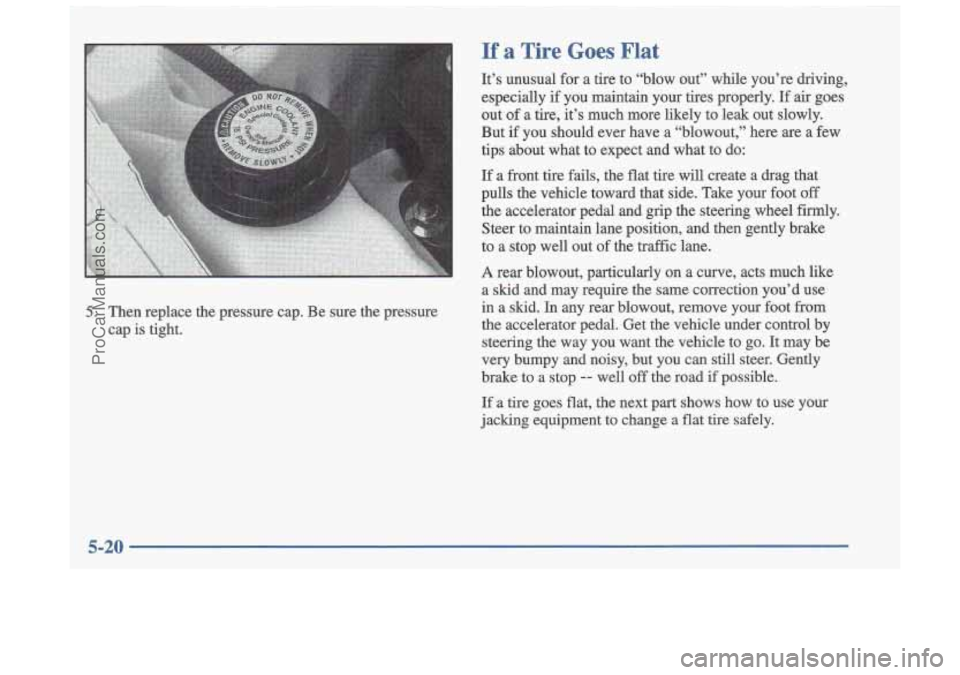Page 197 of 353
NOTICE:
Do not tow with sling-type equipment or fascia
damage will occur. Use wheel-lift or car-carrier
equipment. Additional ramping may be required
for car-carrier equipment. Use safety chains and
wheel straps.
NOTICE: (Continued)
NOTICE: (Continued)
Towing
a vehicle over rough surfaces could
damage
a vehicle. Damage can occur from vehicle
to ground or vehicle to wheel-lift equipment. To
help avoid damage, instan
a towing dolly and
raise vehicle until adequate clearance
is obtained
between the ground and/or wheel-lift equipment.
Do not attach winch cables or J-hooks to
suspension components when using car-carrier
equipment. Always use T-hooks inserted in the
T-hook slots.
5-10
ProCarManuals.com
Page 198 of 353
Rear Towing
NOTICE: (Continued)
Towing a vehicle over rough surfaces could
damage a vehicle. Damage can occur from vehicle
to ground or vehicle to wheel-lift equipment.
To
help avoid damage, install a towing dolly and
raise vehicle until adequate clearance
is obtained
between the ground and/or wheel-lift equipment.
Do not attach winch cables or J-hooks to
suspension components when using car-carrier
equipment. Always use T-hooks inserted in the T-hook slots.
NOTICE:
Do nd tow with sling-type~equipment or the rear
bumper valance
wiiii be damaged. Use wheel-lift
or car-carrier equipment. Additional ramping
may
be required for car-carrier .equipment. Use
safety chains and wheel straps.
-NOTICE: (Continued)
5-11
ProCarManuals.com
Page 207 of 353

5. Then replace the pressure cap. Be sure the pressure
cap is tight.
If a Tire Goes Flat
It’s unusual for a tire to “blow out” while you’re driving,
especially if you maintain your tires properly. If air goes
out of a tire, it’s much more likely to leak out slowly.
But if you should ever have a “blowout,” here are a few\
tips about what to expect and what to do:
If a front tire
fails, the flat tire will create a drag that
pulls the vehicle toward that side. Take your foot
off
the accelerator pedal and grip the steering wheel firmly.
Steer to maintain lane position, and then gently brake
to a stop well out of the traffic lane.
A rear blowout, particularly on a curve, acts much like
a skid and may require the same correction you’d use
in a skid. In any rear blowout, remove your foot from
the accelerator pedal. Get the vehicle under control by
steering the way you want the vehicle to go. It may be
very bumpy and noisy, but you can still steer. Gently
brake to a stop
-- well off the road if possible.
If a tire goes flat, the next part shows how to use your
jacking equipment to change a flat tire safely.
5-20
ProCarManuals.com
Page 208 of 353
Changing a Flat Tire
If a tire goes flat, avoid further tire and wheel damage
by driving slowly to a level place. Turn
on your hazard
warning flashers.
Changing a tire can cause an injury. The vehicle
can dip off the jack and roll over you or other
people. You and they could be badly injured.
Find a level place to change your tire. To help
prevent the vehicle from moving:
1. Set the parking brake firmly.
2. Put the shift lever in PARK (P).
3. lhrn off the engine.
To be even more certain the vehicle won't move,
you can put blocks at the front and rear of the
tire farthest away from the one being changed.
The following steps will tell you how to use the jack and
change a tire.
ProCarManuals.com
Page 209 of 353
Removing the Spare Tire and Tools
The equipment you’ll
need is in the
trunk. Turn
the center retainer nut on
the compact spare cover
to the left to remove it.
Lift and remove the cover. (See “Compact Spare Tire”
later in
this section for more information about the
compact spare.)
You will find the jacking instructions
label
on the underside of the tire cover. Turn
the wing nut to the left
and remove it. Then
lift off
the adapter and remove
the spare tire.
mi
Remove the jack and wheel wrench from the trunk.
Your vehicle’s jack and wheel wrench are stored in
a foam tray.
5-22
-Ib
ProCarManuals.com
Page 210 of 353
The tools you'll be using include the jack (A) and wheel
wrench
(J3).
ProCarManuals.com
Page 211 of 353
2. Some models are equipped with aluminum wheels.
Remove the cover plate to find the wheel nuts.
Carefully use the wedge end of the wheel wrench
to pry it off. 3. Then use the wheel wrench to loosen all the wheel
nuts. Don't remove
them yet.
5-24
ProCarManuals.com
Page 213 of 353
NOTICE:
Do not jack or lift the vehicle using the oil pan.
Pans could crack and begin to leak fluid. When
jacking or lifting your vehicle, always place the
jack in the proper position.
NOTICE:
Do not jack or lift the vehicle using the
suspension components. Suspension components
can be damaged by doing this. When jacking or
lifting your vehicle, always place the jack in the
proper position.
5. Raise the vehicle by turning the wheel wrench to the
right. Raise the vehicle far enough
off the ground so
there is enough room for the spare tire to fit.
6. Remove all of the wheel nuts.
7. Then take off the flat tire.
5-26
ProCarManuals.com